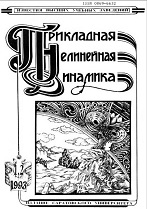|
BIFURCATION IN DYNAMICAL SYSTEMS. DETERMINISTIC CHAOS. QUANTUM CHAOS.
Parametric interaction of modes in the presence of quadratic or cubic nonlinearity
L. V. Turukinaab
a Saratov Branch of Kotelnikov Institute of Radioengineering and Electronics of the RAS, Russia
b Saratov State University, Russia
Abstract:
The purpose of this work is a study of the dynamics of the systems of ordinary differential equations of the second order, which is obtained using the Lagrange formalism. These systems describe the parametric interaction of oscillators (modes) in the presence of a general quadratic or cubic nonlinearity. Also, we compare the dynamics of the systems of ordinary differential equations of the second order and dynamics of the Vyshkind-Rabinovich and Rabinovich-Fabrikant models in order to determine the possibilities of the latter models when modeling coupled oscillators of the above type. Methods. The study is based on the numerical solution using the methods of the theory of the obtained analytically differential equations. Results. For both systems of second-order differential equations, is was presented a chart of in the parameter plane, a graphs of Lyapunov exponents at the value of the parameter that specifies the dissipation of oscillators, a time dependences of the generalized coordinates of oscillators and its amplitudes, portraits of attractors, a projection of the attractors on a phase planes of oscillators. A comparison with the dynamics of the Vyshkind-Rabinovich and Rabinovich-Fabrikant models is carried out. These models are three-dimensional real approximations of the above systems obtained by the method of slowly varying amplitudes. Conclusion. The study of the constructed systems showed that in the parameter space there are regions corresponding to both various regular regimes, such as the equilibrium position, limit cycle, two-frequency tori, and chaotic regimes. For both systems, it was shown that the transition to chaos occurs as a result of a sequence of period doubling bifurcations of the tori. In addition, a comparison of the dynamics of the constructed systems with the dynamics of the Vyshkind-Rabinovich and Rabinovich-Fabrikant models allows us to assert that if the Vyshkind-Rabinovich model predicts the dynamics of the corresponding initial system well enough, then the Rabinovich-Fabrikant model does not have such a property.
Keywords:
parametric interaction of the oscillators, chaotic attractors, Lagrange formalism, Lyapunov exponents
Received: 28.04.2023
Citation:
L. V. Turukina, “Parametric interaction of modes in the presence of quadratic or cubic nonlinearity”, Izvestiya VUZ. Applied Nonlinear Dynamics, 32:1 (2024), 11–30
Linking options:
https://www.mathnet.ru/eng/ivp572 https://www.mathnet.ru/eng/ivp/v32/i1/p11
|

|




 Contact us:
Contact us: Terms of Use
Terms of Use
 Registration to the website
Registration to the website Logotypes
Logotypes








 Citation in format
Citation in format 